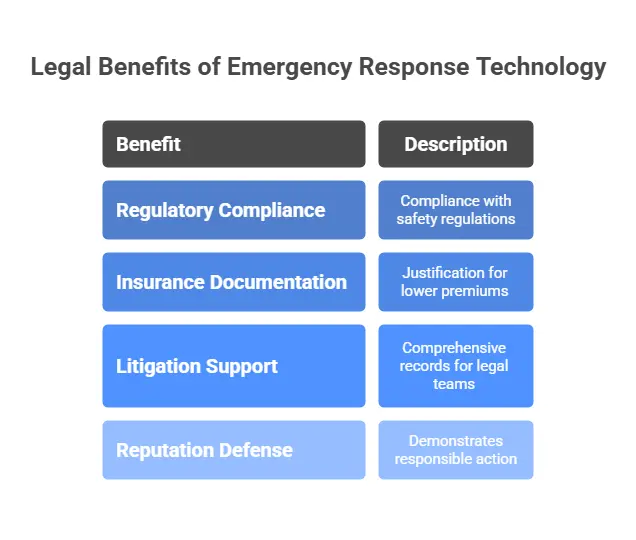In the aftermath of an emergency—whether it’s a fire, active shooter, flood, or earthquake—building owners often find themselves not only dealing with the physical aftermath but also facing the legal consequences of perceived negligence.
When lives are lost or property is damaged, questions quickly arise:
Was this preventable? Did the owner take reasonable precautions? Was there a disaster preparedness plan in place?
As a provider of cutting-edge emergency management solutions and business continuity software, Building Safety Solutions (BSS) understands the high stakes building owners face.
Courts and insurance carriers are increasingly scrutinizing whether building operators have implemented proper emergency protocols and digital planning tools to minimize harm and chaos.
Demonstrating due diligence isn’t just best practice—it’s a legal shield.
What Is Due Diligence
Legally, due diligence refers to the reasonable steps a person or organization takes to prevent harm. In building safety, this means:
- Conducting risk assessments
- Training staff and tenants
- Installing proper life-safety systems
- Maintaining updated and accessible emergency plans
- Using technology to support real-time emergency response and documentation
In corporate liability litigation, failing to demonstrate these efforts can lead to significant damages—even if the emergency itself was beyond your control.
Case Studies: When Lack of Preparedness Led to Lawsuits
1. Ghost Ship Warehouse Fire – Oakland, California (2016)
Background: A fire broke out during an unpermitted concert inside a converted warehouse, killing 36 people.
Legal Outcome: Multiple lawsuits were filed against the building owner, city officials, and PG&E. Plaintiffs alleged gross negligence and lack of safety measures.
Key Failure: No fire alarms, sprinklers, or evacuation plans. The building owner could not provide evidence of any formal emergency planning.
Takeaway: If basic safety protocols and plans aren’t documented or accessible, a defense becomes difficult—even if the emergency was caused by tenants or third parties.
2. Champlain Towers Collapse – Surfside, Florida (2021)
Background: A 12-story residential building partially collapsed, killing 98 people.
Legal Outcome: Over $1 billion in settlements. The condo association and others were accused of ignoring structural warnings and failing to implement preventative measures.
Key Failure: Poor documentation of maintenance and safety inspections, despite known risks.
Takeaway: In court, written reports and digital records demonstrating proactive risk management are crucial. Verbal assurances or undocumented meetings offer no protection.
3. Station Nightclub Fire – West Warwick, Rhode Island (2003)
Background: Pyrotechnics ignited flammable acoustic foam, killing 100.
Legal Outcome: Owners and the band were criminally charged. Civil suits exceeded $175 million.
Key Failure: Lack of proper emergency exits, failure to follow occupancy rules, and no accessible evacuation planning.
Takeaway: Modern digital emergency software could have helped maintain compliance, training records, and occupancy control—evidence that could support a claim of due diligence.
How to Demonstrate Due Diligence in Court
The key to legal protection in the face of liability exposure is being able to prove that all reasonable steps were taken before, during, and after an emergency.
That’s where Building Safety Solutions comes in.
1. Digital Documentation of Emergency Plans
Courts want proof that emergency plans existed—and were followed. Paper binders are easily lost or outdated. BSS First Responder software centralizes:
- Emergency contact information
- Evacuation maps
- First responder access protocols
- Tenant rosters
- Real-time plan updates
2. Training & Drill Records
Regular safety drills and employee/tenant training are expected. Our platform tracks participation, frequency, and compliance—creating a defensible record in court.
Example Defense: “Your Honor, here is our log showing quarterly fire drills for the past 3 years, each digitally signed by 85% of tenants.”
3. Real-Time Response Logs
If an incident occurs, BSS software records:
- Time-stamped alerts
- Communication logs with first responders
- Response team activity
- Incident escalation procedures
This creates a digital paper trail that supports your narrative and shows the emergency was handled responsibly.

Legal Benefits of Emergency Response Technology
Investing in digital preparedness is not just operationally sound—it’s a risk mitigation strategy. Building Safety Solutions helps protect your brand and your bottom line with:
- Regulatory compliance with OSHA, NFPA, and local codes
- Insurance documentation to justify lower premiums or defend claims
- Litigation support, offering comprehensive records for legal teams
- Reputation defense: Show tenants, media, and courts that you acted responsibly
What the Courts Expect Today
Modern juries and judges are increasingly tech-literate and expect building owners to use available technology to mitigate harm. Failing to adopt proven systems can be interpreted as willful negligence.
“You had access to technology that could have prevented or mitigated this, yet chose not to use it?”
That’s a question no property owner wants to hear in court.
Don’t Be Caught Unprepared
Emergencies are inevitable—lawsuits don’t have to be. Proactive investment in emergency response technology is not only a moral and operational imperative but a legal necessity.
Building Safety Solutions empowers property owners, facility managers, and corporate leadership to prove their commitment to life safety, compliance, and due diligence.
Our disaster response software solutions are used by Fortune 500 companies, by some of the largest property owners in the nation, and are implemented in some of the most prominent buildings in the country, including One World Trade Center, 3, 4 , and 7 World Trade Center.
Contact us for a free demo or consultation to see how the BSS suite of products can help maintain your business in the event of an unforeseen emergency.

